In This Issue
Message From the
Executive Director
Support VSI
Camp Discovery 2016
Treatment Expectations
What's On Your Mind?
- Should I have Protopic on my skin
during my light treatment?
- Is it safe to remove the goggles
during my light treatment?
Medical News Updates
- Permanent Hair Dyes and Vitiligo
- Scenesse-Clinuvel Update
Research & Clinical Trials
Bibliography & Sources
New! Support VSI With eBay
Earn Funding for VSI
When you Shop!
 Now Visit VSI Now Visit VSI
on Facebook
 And Twitter And Twitter
View Past Newsletters
VSI Medical and Scientific
Advisory Committee
- Pearl E. Grimes, M.D., Committee Chair
- Ted A. Grossbart, Ph.D.
- Sancy A. Leachman, M.D.
- I. Caroline Le Poole Ph.D.
- Mauro Picardo, M.D.
- Nanette B. Silverberg, M.D.
- Richard A. Spritz, M.D.
- Alain Taieb, M.D., Ph.D.
- Wiete Westerhof, MD, Ph.D.
|
| |
| |
How to Log In:
Have you have forgotten your Login ID and/or Password?
No Problem!
Just go to the
Community Page
Scroll down to
the login box.
LOOK UNDERNEATH!
You'll see instructions to have them sent to the email address on your account. |
|
How to Log In:
Have you have forgotten your Login ID and/or Password?
No Problem!
Just go to the
Community Page
Scroll down to
the login box.
LOOK UNDERNEATH!
You'll see instructions to have them sent to the email address on your account.
|
|
How to Log In:
Have you have forgotten your Login ID and/or Password?
No Problem!
Just go to the
Community Page
Scroll down to
the login box.
LOOK UNDERNEATH!
You'll see instructions to have them sent to the email address on your account.
|
|
How to Log In:
Have you have forgotten your Login ID and/or Password?
No Problem!
Just go to the
Community Page
Scroll down to
the login box.
LOOK UNDERNEATH!
You'll see instructions to have them sent to the email address on your account.
|
|
| |
| Contact Us
Online
VitiligoSupport.org
Email Contact Us
Postal Mail Address
Vitiligo Support International
P.O. Box 3565
Lynchburg Va 24503
Phone
(434) 326-5380 |
|
|
Message From the Executive Director


Dear Members and Friends of VSI,
When the days are long, and requests for services and support seemingly unrelenting, it can be difficult to fully appreciate the impact of VSI’s outreach.
But each fall, as I reflect on the past year, I am once again encouraged by the progress.
Thanks in large part to VSI’s recruitment efforts for vitiligo research studies, we now know far more about specific vitiligo genes and pathways, which has resulted in major drug companies pursuing generalized vitiligo as a treatment target.
The President of the American Academy of Dermatology and staunch vitiligo advocate, Dr. Mark Lebwohl, has joined VSI in its battle to abolish the discriminatory practices of the insurance industry that limit or deny coverage for vitiligo. Since he successfully led this same crusade many years ago on behalf of psoriasis, we appreciated the recent opportunity to collaborate and strategize with Dr. Lebwohl, and to advocate with him during Capitol Hill visits with key legislators.
VSI continues to partner with an international group of world-renown vitiligo clinicians, researchers, and scientists, bringing the voice of the patient to this consortium. As the patient representative, we’ve worked to open the lines of communication between physicians and patients, thereby bridging the gap between....
the erroneous preconceived notion that vitiligo doesn’t hurt,
and the reality of the emotional burden of this disease.
As part of this process, we are addressing the vast disconnect between viable, available, treatments and the paltry number of patients with positive treatment outcomes. The concept we strive to convey is that compliance and eventual outcome is less about a prescription, and more about communication, respect and understanding.
VSI’s roots are deep in patient support – but it’s important to recognize that VSI is far more than a support group. VSI not only provides support and educational resources to patients from all over the world, but
VSI is the only vitiligo organization actively engaged in
national level collaboration working to improve the future of vitiligo.
As far as we’ve come, the unmet needs of this community are enormous. Vitiligo has been in the shadows of other more successfully-funded diseases for far too long. With the strong and unified financial support of the community we serve, we can make a difference.
In the words of Mahatma Gandhi, “You must be the change you wish to see in the world.”
Your investment in VSI is your commitment to a better future.
Please Consider Supporting VSI Today.
Sincerely,

Jackie Gardner
Executive Director
Please Support VSI!
 When you donate to VSI, you are not only supporting its quarterly newsletters, When you donate to VSI, you are not only supporting its quarterly newsletters,
you are helping to sustain patient assistance; educational resources; and organizational programs and services that include national-level advocacy efforts to abolish the discriminatory practices of the insurance industry for vitiligo treatments, improve patient access to care, and increase skin disease medical research funding.
VSI needs your support to provide these valuable services.
Please Click Below and Become a Supporter Today!
 Become a VSI Supporting Member! Become a VSI Supporting Member!
Make a Donation Through VSI
Contribute through PayPal |

|
This organization is a Silver-level GuideStar Exchange
participant, demonstrating its commitment to transparency. |

2016 Save the Date:
Camp Discovery!
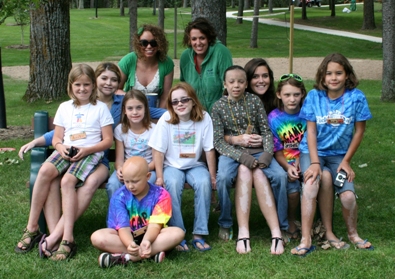
The American Academy of Dermatology’s (AAD) Camp Discovery program is for children ages 8-16 who have a chronic skin disease. Under the expert care of dermatologists and nurses, Camp Discovery gives campers the opportunity to spend a week with other young people with skin conditions having fun and participating in activities such as swimming, horseback riding, arts and crafts and many more. There is no fee to attend, all costs including transportation, are provided by the AAD through generous donations from its members, outside organizations and individuals.
- All children must be referred by their dermatologist and referral forms will be available on campdiscovery.org, beginning in mid-January.
- The volunteer application is also available on campdiscoveyr.org. Applicants must be at least 18 years of age and provide one letter of recommendation.
- There is no fee to attend, all costs including transportation, are provided by the AAD through generous donations from its members, outside organizations and individuals.
June 19-24: Camp Little Pine, Crosslake, MN (ages 10 -14)
June 20-24: Camp Reflection, Carnation, WA (ages 9 -16)
July 3 – 8: Camp Big Trout, Crosslake, MN (ages 14 -16)
August 7-12: Camp Dermadillo, Burton, TX (ages 9 -15)
August 13 -19: Camp Horizon, Millville, PA (ages 8 -13)
August 7-13: Camp Liberty, Andover, CT (ages 8 -16)
For more information about attending or volunteering:
Visit www.campdiscovery.org, or contact Janine Mueller at 847-240-1737, or [email protected]

How Can I Tell if My Treatment is Working:
What Should I Expect?
Many factors are involved with treatment response. Some people will begin to see results within 3 to 6 months. Others may not see results for 8 months. The rule of thumb is that you will need to allow at least 3 to 6 months of consistent use before you begin to see results from ANY treatment. Additionally, you should expect to treat for up to two years or longer in order to see good results. If you try a treatment for 3 months and then quit because you saw no results, chances are you needed more time. It is vital to use any treatment consistently and correctly. If you don’t use a treatment as directed, it can take much longer to work or may not work at all.
Treatment results will vary based on multiple factors.
- Area of the body being treated:
The face and neck generally respond quite well, while feet and hands are more difficult and take more time.
- Duration (length of time) of depigmentation:
Generally the earlier you treat, the better the response. Even feet and hands have been shown to respond well when treated very early. However, you should never be discouraged from trying a treatment simply because of the age of the depigmentation. With patience and dedication, you can still regain pigment with mainstream treatments, and if unsatisfied with those results, there are always surgical treatments.
- Age of patient:
Children typically respond better than adults.
- Type of vitiligo:
Generalized vitiligo typically responds best to mainstream treatments; however, even segmental vitiligo has been shown to respond well if treated quite early.
- Treatment protocol:
Combination treatments (such as a topical and light) typically produce results more quickly than a monotherapy treatment, such as light or a topical, being used alone.
- Frequency of use of treatment:
Topicals are generally prescribed to be used twice daily.
Light treatment is most effective when used at least 3 days a week.
- Underlying conditions:
If a person has lost quite a bit of pigment in a very short time, it may be necessary to determine and treat the cause. Some underlying conditions frequently seen with vitiligo are autoimmune thyroid disease, type 1 diabetes, rheumatoid arthritis, celiac disease, and *vitamin D deficiency.
- Disease Activity:
If the vitiligo is spreading quickly with a fair amount of pigment loss, it may be necessary to use some type of systemic treatment to stabilize the vitiligo. A topical treatment can only treat the area to which it is applied. It cannot stop new lesions from forming. Depending upon the degree and activity of pigment loss, some doctors will prescribe a corticosteroid (either oral or injection) to stabilize. Full body light treatment can also suppress the immune response and stabilize vitiligo.
- Extent of depigmentation:
Topical treatments are generally prescribed as a first line of therapy for those with less than 20% of depigmentation. However, for those with greater pigment loss, light therapy is generally more efficient.
* Multiple studies have pointed to a possible connection between vitiligo and vitamin D levels. One study of a village in Romania found many families with vitiligo and other autoimmune diseases who also had a genetic abnormality in a vitamin D receptor (VDR) gene. A similar genetic abnormality in the VDR gene was found by Chinese investigators in 749 patients with vitiligo, adding additional evidence of a connection between this gene and vitiligo.
A 2010 US study also found evidence of a potential vitamin D linkage. A majority of vitiligo patients were found to have low to very low levels of vitamin D. Also, in this group over 13% had secondary autoimmune disease. The study authors concluded that very low vitamin D levels would be a good screening criteria for the presence of additional autoimmune disease in vitiligo patients.
For additional information on diagnostic tests for vitiligo: Click here
Treatment Expectations
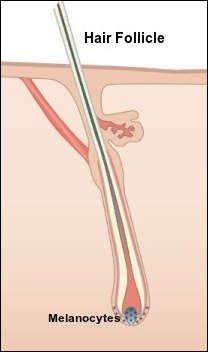  Many people become discouraged and either begin to slip away from their daily routine, or even discontinue treatment, because they didn’t have a clear understanding of the process and know what to expect from their treatment. Many people become discouraged and either begin to slip away from their daily routine, or even discontinue treatment, because they didn’t have a clear understanding of the process and know what to expect from their treatment.
Vitiligo is a genetic autoimmune disease where the body mistakenly targets and attacks its own melanocytes (pigment-making cells) leaving patches of depigmented skin. Melanocytes are mostly found at the base of hair follicle, but can also be found in the outer layer of the skin, or epidermis.
Regenerating new pigment takes time. First, the treatment needs to stop the immune response that is killing the melanocytes, then new melanocytes need to form in the hair follicle, then they have to slowly work their way up from the base of the hair follicle to the epidermis. Each step of the process can take several weeks, if not longer. So patience will be the key to success.
  What does new pigment look like? What does new pigment look like?
You might first see a tiny freckle appearing near a hair follicle somewhere inside of the depigmented area. Over time this freckle will continue to grow bigger and hopefully other freckles will also appear nearby. In time, these freckles will grow together, eventually filling the depigmented area.
The other way new pigment can begin is when melanocytes from the outer
edges of the depigmented area migrate inward, slowly closing the depigmented area from the outside.
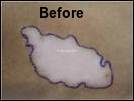  
Photos used with permission from Dr. Anantha Prasad Holla, Director: MelanoSite;
Center of Advanced Vitiligo Treatment and Collaborative Pigment Cell Research based in Delhi and Mangalore.
As new pigment begins to appear, some people will experience hyperpigmentation (darker than normal skin color) as seen in the After photo above. This ordinarily subsides in time and the color will even out to the normal skin tone.
Treatments
Most vitiligo treatments fall into one of two categories:
1. Immunosuppressive: Treatments that suppress the melanocyte destruction
Such as: Protopic (tacrolimus), Elidel (pimecrolimus), and corticosteroids (Ultravate)
2. Immunoregulatory: Treatments that promote melanocyte repopulation
Such as: Narrowband UVB (NB-UVB)
|
There are 3 primary types of treatment used for repigmentation.
- Topicals: corticosteroid, Protopic/tacrolimus, Elidel/pimecrolimus
These suppress the melanocyte destruction
- Phototherapy: NB-UVB, UVA, Excimer laser
These promote melanocyte repopulation
- Surgical: tissue and cellular grafts
These replace the areas of vitiligo with normal skin and/or cells
What to expect from a topical (ointment or cream) treatment:
  Topical treatments alone usually take longer to produce results than either light alone or a topical combined with light. With a topical alone, results might not be evident for 8 months or longer. Topicals combined with light generally produce results even faster than with light alone. Once again, it is very important for topical treatments to be used as prescribed with regard to frequency of treatment, method of application and how long the topical should be left on prior to washing. Topical treatments alone usually take longer to produce results than either light alone or a topical combined with light. With a topical alone, results might not be evident for 8 months or longer. Topicals combined with light generally produce results even faster than with light alone. Once again, it is very important for topical treatments to be used as prescribed with regard to frequency of treatment, method of application and how long the topical should be left on prior to washing.
How do I use light as a treatment?
When using phototherapy such as NB-UVB, the goal is to expose the depigmented area to the light source long enough so that within 12-18 hours after the light exposure you see a nice pink color. This is similar to the reaction you see when exposing your skin to sunlight. Remember that depigmented skin is more light sensitive than your non-affected skin. You should always begin conservatively so as not to burn, then increase your time slowly until you gain the desired effect.
  You never want to burn (turning red rather than pink) pigmented OR depigmented skin, as it is unhealthy for your skin and this type of trauma can actually cause vitiligo to spread or worsen. As a rule of thumb, you treat one day, the next day you should see a light pink color. If the pink is gone the following day, then you can treat again. You never want to burn (turning red rather than pink) pigmented OR depigmented skin, as it is unhealthy for your skin and this type of trauma can actually cause vitiligo to spread or worsen. As a rule of thumb, you treat one day, the next day you should see a light pink color. If the pink is gone the following day, then you can treat again.
Treating 3 times a week on non-consecutive days is considered optimal by most. Research has shown that a more aggressive treatment schedule (3 or 4 days a week) will achieve more pigment in a shorter time period than 1 or 2 days a week. However, when comparing the results based on the actual number of treatments, those only treating twice a week, eventually achieved the same degree of repigmentation; it just took longer. While those only treating once a week did achieve repigmentation over time, when compared to those treating more frequently, the results never quite achieved the same degree of repigmentation.
How long are NB-UVB treatment times?
 Beginning NB-UVB treatment times would likely be around 15-20 seconds. If you do not see any pinkness within 12-18 hours, you can use NB-UVB again the next day and increase the time by 5-10 seconds, and so on. Once you reach a level where you get pink but do not burn, and the color goes away within 24-36 hours, you can maintain that time until you no longer achieve pink. Some people will remain at the same level for weeks or months. Once you no longer see pink, you probably need to increase your time again. Always take care when increasing time that you do not increase too much. It is better to take an extra day to achieve the desired results than it is to risk burning. Beginning NB-UVB treatment times would likely be around 15-20 seconds. If you do not see any pinkness within 12-18 hours, you can use NB-UVB again the next day and increase the time by 5-10 seconds, and so on. Once you reach a level where you get pink but do not burn, and the color goes away within 24-36 hours, you can maintain that time until you no longer achieve pink. Some people will remain at the same level for weeks or months. Once you no longer see pink, you probably need to increase your time again. Always take care when increasing time that you do not increase too much. It is better to take an extra day to achieve the desired results than it is to risk burning.
How long should I expose my skin if I am using sunlight to treat?
 That depends on several factors such as the time of year and your latitude (proximity to the sun). The closer to the equator you are, the stronger the rays. Sunlight generally takes a little longer exposure than NB-UVB because sunlight contains the full light spectrum rather than only the therapeutic rays of NB-UVB. As mentioned above, remember that depigmented skin is far more sensitive to light than your unaffected skin, and always begin sun exposure very conservatively and build up in order not to burn. Depending upon the time of year and the climate, a general rule of thumb would be to begin with around 10 - 15 minutes of sun, increasing the time minimally as needed to maintain the therapeutic dose (getting pink). That depends on several factors such as the time of year and your latitude (proximity to the sun). The closer to the equator you are, the stronger the rays. Sunlight generally takes a little longer exposure than NB-UVB because sunlight contains the full light spectrum rather than only the therapeutic rays of NB-UVB. As mentioned above, remember that depigmented skin is far more sensitive to light than your unaffected skin, and always begin sun exposure very conservatively and build up in order not to burn. Depending upon the time of year and the climate, a general rule of thumb would be to begin with around 10 - 15 minutes of sun, increasing the time minimally as needed to maintain the therapeutic dose (getting pink).
Photograph Your Progress!
  One of the best (and most accurate) ways to tell if (or how well) your treatment is working is to begin with good photos of the areas you are treating. If you ever become discouraged with your progress, once you go back and see where you began, most likely you will be quite surprised and encouraged! One of the best (and most accurate) ways to tell if (or how well) your treatment is working is to begin with good photos of the areas you are treating. If you ever become discouraged with your progress, once you go back and see where you began, most likely you will be quite surprised and encouraged!
Many VSI members have posted pictures of their treatment progress in the member photo galleries. If you ever question how well treatments work, you should visit the galleries.
For additional treatment information: Click here

Back to Top

What's On Your Mind?
Q. My doctor prescribed 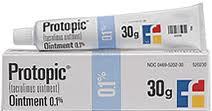 Protopic and NB-UVB for me. Protopic and NB-UVB for me.
Should I have the Protopic on my skin while using the light?
- While having Protopic on your skin during a light treatment may or may not reduce the therapeutic effect, it will not help.
Some topicals need to be on the skin when using light because they are "light-sensitizing." This is the case for example, with PUVA treatment. PUVA stands for Psoralen + UVA (light). A psoralen is a light-sensitizing drug and needs to be either taken orally, or applied to the skin (topically), just prior to exposure to the light treatment or exposure in order to make the skin more sensitive and responsive to the light.
Although Protopic does make the skin more sensitive in some individuals, it is not classified as a light-sensitizing drug. Vitiligo is an autoimmune disease where the body mistakenly identifies its own melanocytes (pigment-making cells) as a foreign substance and attacks and kills them. When (and where) Protopic is applied to the skin, as an immunomodulating drug, its function is to block (turn off) the immune response, allowing the melanocytes to again flourish.
Protopic's ability to block the immune response is a somewhat cumulative process. It's not immediate like a psoralen, and it does not need light in order to work. If applied daily, after a period of several weeks or even months, the melanocytes once again begin to repopulate the previously depigmented area.
By adding light to this or any therapy, you are increasing melanocyte stimulation. NB-UVB stimulates melanocytes whether or not Protopic is being used. Protopic suppresses the immune response where applied whether or not light is used. One is not dependent on the other.
 Q. I am using NB-UVB light, butwearing goggles. Is it safe to remove the goggles to expose my eyelids to the light? Q. I am using NB-UVB light, butwearing goggles. Is it safe to remove the goggles to expose my eyelids to the light?
- Research has shown that NB-UVB light does not penetrate the eyelid. As long as no psoralen is being used (as with PUVA), the patient is old enough to understand they must keep their eyes closed at all times, and has an annual eye exam, it should be safe to expose the eyelid to NB-UVB light.

Medical News Updates
Highlights of recently-published medical
articles on vitiligo and its treatments
Permanent Hair Dyes and Vitiligo
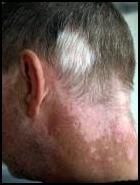  Over the years, VSI has reported both anecdotal and clinical information connecting an increased risk of vitiligo with the hair dyes now used by an estimated 70% of women in the US. While the potential link had been indicated in previous case reports, a November 2015 study using over 30 years of collected data showed a direct correlation between use of the permanent hair dyes and vitiligo. The highest risk appeared to be among those who started using the dyes at an earlier age and for those using them for the longest period of time. Over the years, VSI has reported both anecdotal and clinical information connecting an increased risk of vitiligo with the hair dyes now used by an estimated 70% of women in the US. While the potential link had been indicated in previous case reports, a November 2015 study using over 30 years of collected data showed a direct correlation between use of the permanent hair dyes and vitiligo. The highest risk appeared to be among those who started using the dyes at an earlier age and for those using them for the longest period of time.
The authors cited a 2013 vitiligo outbreak in Japan among 16,000 users of a skin-lightening cream containing a phenol called rhododenol. While pigment loss where the cream was applied was to be expected, many users also developed depigmentation on remote areas of their bodies. This led researchers to believe that these type of phenols have the capacity to trigger the same type of systemic autoimmune response seen by those using monobenzyl ether of hydroquinone (MBEH) to depigment the entire body. This reaction is consistent with the observation of systemic pigment loss (not limited to the scalp) from the use of hair dyes.
The study concluded that common household products could be an environmental risk factor triggering a systemic autoimmune response (pigment loss on areas of the body not exposed to the product) in those predisposed to vitiligo. Further research will be critical to identifying the specific chemical compounds in hair dyes and commonly used products which can be linked to vitiligo.
Editor’s Note:
Previous VSI newsletters have included the following list of chemicals known to cause pigment loss.
Butylated Hydroxytoluene (BHT);
P-Phenylenediamine (aka- para-phenylenediamine - ppd or P-Phenylenediamine)
P-Amonophenol
4-Amino-2-Hydroxytoluene
M-Aminophenol
Benzyl alcohol
P-Aminophenol
Source: Ray Boissy, Ph.D., Professor of Dermatology & Cell Biology and
Director of Basic Science Research at the University of Cincinnati College of Medicine
Scenesse Phase ll Preliminary Results and
Update on North American Program
  Scenesse (known generically as afamelanotide) is a brand name drug developed for vitiligo by Clinuvel Pharmaceuticals. The product, about the size of a grain of rice, is implanted by a physician into the fatty area of the hip and works by activating the production of melanin in the skin. The effects become visible approximately 2 days Scenesse (known generically as afamelanotide) is a brand name drug developed for vitiligo by Clinuvel Pharmaceuticals. The product, about the size of a grain of rice, is implanted by a physician into the fatty area of the hip and works by activating the production of melanin in the skin. The effects become visible approximately 2 days
later as the skin begins to darken.
The company cites goals of improving the intensity and extent of repigmentation and reducing overall
treatment time, thereby reducing the financial and scheduling burdens of current treatments, which
can include NB-UVB therapy several times per week for 18 months or longer. They also hope to improve
the long-term retention of pigment.
The drug has been tested in multiple trials with participants split into two groups: one receiving
combination therapy treated with NB-UVB and the Scenesse implant, and the other, a monotherapy
group receiving NB-UVB alone.
The combination therapy resulted in much greater repigmentation on the face and upper extremities,
and results were seen, on average, 20 days earlier than in those on NB-UVB phototherapy alone.
In December 2015, Clinuvel released two updates:
North American update: The program is reporting positive results and assessments from both physicians and patients. They noted that as seen in previous Scenesse studies, those with darker skin complexions seem to respond best. The company is working closely with the FDA to complete the many clinical protocols, which currently include a six-month placebo-controlled preclinical study to further demonstrate the ongoing safety of the drug protocol.
Although another two or three advanced clinical trials are anticipated prior to submitting a new drug application in the US, the testing centers and dates have not yet been announced. Clinuvel will notify VSI, and we will post updates, once additional information is available.
Preliminary Results of Phase ll Singapore Study: Clinuvel is pleased with the positive results being reported from Singapore, specifically chosen as a testing site in order to better evaluate a “rigorous protocol tailored to darker skin types where we have seen the most promising clinical results to date,” Clinuvel’s Director of Clinical Affairs, Dr. Emilie Rodenburger said.
Observations from the Singapore trial are consistent with previous studies showing the combination therapy being both safe and effective while producing near complete and progressive repigmentation of the affected skin.
Back to Top

Research & Clinical Trials
Phototherapy Study in Baltimore, MD.
Phototherapy Clinical Trial
for Generalized Vitiligo
Principal Investigator: Dr. Ginette Okoye
Study Location:
Johns Hopkins Outpatient Center
Department of Dermatology, Baltimore, MD.
Vitiligo is a chronic acquired skin disease of pigmentation that affects patients’
quality of life across all degrees of involvement and severity. Phototherapy is a
clinically indicated treatment for skin lesions. In this study, we are going to
evaluate the efficacy and safety of phototherapy in the treatment of vitiligo as
well as impact on quality of life.
Inclusion Criteria:
Must be over the age of 18
Must have a diagnosis of vitiligo that involves both sides of the body.
Participation Involves:
Phototherapy treatments (3 times per week for 6 months)
Questionnaires on how vitiligo affects the quality of your life
Small skin biopsies of your skin
If you are interested in participating or would like more information:
Contact: Dermatology Research
Phone: 410-502-7546 or Email: [email protected] |
Pilot Study In Boston, MA.
Open-label Pilot Study of
Abatacept for the Treatment of Vitiligo
Principal Investigator: Dr. Victor Huang
Study Location:
Brigham and Women’s Hospital Clinical Research Program
221 Longwood Ave. Boston, MA 02115
Abatacept has been shown to decrease T cell activity and reduce symptoms associated with rheumatoid arthritis. Similar pathways have been shown to be involved in vitiligo.
This study is seeking adult patients with active vitiligo to receive 24 weekly self-administered injections of abatacept, to see if the vitiligo lesions stop spreading, and start to repigment.
A 32 week follow-up visit will be performed to evaluate secondary endpoints as well.
Inclusion Criteria:
Must be over the age of 18
Must have actively progressive vitiligo (defined as development of new lesions or worsening of existing lesions within the past 6 months) covering at least 5% of body surface area
Subjects receiving treatment at the time of screening will be eligible providing they undergo a wash out period prior to starting the study
Women of childbearing potential (WOCBP) must be using an acceptable method of contraception throughout the study and for up to 10 weeks after the last dose of study drug, and have a negative serum or urine pregnancy test result (minimum sensitivity 25 IU/L or equivalent units of HCG) within 0 to 48 hours before the first dose of study drug
Sexually active fertile men must use effective birth control if their partners are WOCBP
Exclusion Criteria:
Pregnant or breastfeeding patients
Patients with segmental, acrofacial, or universal vitiligo
Patients with evidence of white hairs within the majority (>50%) of their vitiligo lesions
Patients currently on any other systemic biologic medication, current use of Abatacept, or any other systemic biologic medication within 2 months of study
Use of systemic immunosuppressive agent within 2 weeks prior to initiation of Abatacept
For additional study criteria see contact information below.
If you are interested in participating or would like more information:
Contact the Study Coordinator:
Andrea Craft at: 617-525-3161 or [email protected] |
Segmental Vitiligo Study in Detroit, MI. and Worcester, MA.
Study to Identify the Autoimmune Mechanism
Behind Segmental Vitiligo
Principle Investigators

Study Locations:
UMass Dept. of Dermatology
55 N. Lake Ave
Worcester, MA 01655
| | Henry Ford Dept. of Dermatology
3031 West Grand Boulevard
Detroit, MI 48202 |
Scientists from three United States academic centers are collaborating to identify how
and why the immune system initiates an autoimmune attack against specific pigment
cells in segmental vitiligo. By understanding why this happens, new treatments targeting
this process can be designed.
In segmental vitiligo, pigment cells on one side and area of the body are destroyed
leaving a white area behind. One theory as to why this specific area loses its pigment
cells is the pigment cells in segmental vitiligo may express different proteins from
other pigment and non-pigment cells in the body. In order to identify these differences,
a thin piece of repigmented (regain of color) vitiligo skin and sample of blood is needed.
Your participation is vitally needed
Eligibility requirements:
- Ages: 7-89 years of age
- Diagnosis of segmental vitiligo
- At least 1 spot of repigmentation (regain of color) within the segmental vitiligo
Exclusion Criteria: The following will not be eligible:
- Diagnosis of generalized vitiligo
What will happen if I participate?
- A small amount of blood will be collected in the same manner as blood drawn at your regular doctor’s office.
- A superficial piece of tissue (shave biopsy) will be taken from the area of segmental vitiligo. Shave biopsies are a common procedure performed at dermatology offices.
To participate, or for more information:
Contact: Dr. Tasneem Mohammad
Phone: 313-916-6964 or Email: [email protected] |
Autoimmune Vitiligo Study in Detroit
Role Of Immunosuppressive Cells In The Development Of Vitiligo
Principle Investigator:

Iltefat Hamzavi M.D.
Study Location:
Henry Ford Department of Dermatology,
3031 West Grand Boulevard Detroit, MI. 48202
Patients with vitiligo often have either a personal or family history of other
autoimmune conditions. This association may be due to a common underlying
immune mediated mechanism. As humans have an active immune system to fight
off infections and viruses, a check-and-balance system exists to keep the immune system from attacking your own cells. When the immune system attacks the body’s
own cells, we call this an autoimmune condition. In our study, we are trying to assess
the role of regulatory cells for the immune system in the development of vitiligo.
Ultimately, the goal of this research is to find new therapeutic strategies for
autoimmune vitiligo to stop an ongoing immune attack on pigment cells in active vitiligo
Eligibility requirements:
- Ages: 18-89 years of age
- Diagnosis of generalized vitiligo
- No personal or family history of other autoimmune conditions is required.
Exclusion Criteria: The following will not be eligible:
- Women who are lactating, pregnant or planning to become pregnant
What will happen if I participate?
- Demographic (age, gender, ethnicity) and medical history will be collected.
- A small sample of blood will be collected in the same way that blood is drawn at your regular doctor’s office.
To participate, or for more information:
Contact: Dr. Tasneem Mohammad
Phone: 313-916-6964 or Email: [email protected] |
Needling Clinical Trial in New Jersey
Assessing the Efficacy of Needling
With or Without Corticosteroids in the Repigmentation of Vitiligo
Principal Investigator:
Babar Rao MD

Study Location:
Rutgers - Robert Wood Johnson Medical School
1 World’s Fair Dr, Somerset, NJ.
Needling is an office-based procedure that transposes healthy, pigmented skin cells to depigmented areas using a needle. This trial will investigate the use of needling to treat vitiligo. It will compare needling alone to needling with corticosteroid.
Eligibility Requirements:
- Ages: 18 – 89 years
- Patients with 3 or more localized patches of stable vitiligo
- No prior treatment or had failed previous vitiligo treatments.
Exclusion Criteria:Those with the following will not be eligible:
- Unstable vitiligo (no new or changing lesions in past 6 months)
- Allergic to triamcinolone
- Using systemic treatments
- Pregnant
If you are interested in participating or would like more information:
Contact: Aida – 732-235-7765 or Danielle - [email protected] |
Melanocyte-Keratinocyte Transplant Procedure
Opportunity in Detroit!
Comparative Study Using Dermabrasion versus CO2 Laser
and Collagen Dressing versus Vaseline Gauze in MKTP
Principle Investigator: Iltefat Hamzavi, MD
Study Location:
Henry Ford Department of Dermatology,
3031 West Grand Boulevard Detroit, MI. 48202
The melanocyte keratinocyte transplant procedure (MKTP) involves transplantation
of the skin cells that produce pigment from your normal skin to the depigmented skin. The procedure takes approximately 4 hours and is done under local anesthesia.
This is a prospective, open-label, parallel study comparing two different techniques
for preparing the depigmented skin (carbon dioxide laser versus dermabrasion)
and comparing two different wound dressings (collagen dressing versus vaseline impregnated gauze) for the melanocyte keratinocyte transplant procedure.
Eligibility Requirements:
- Must be 18 years of age or older
- Must have depigmented patches of skin
Exclusion Criteria:
- History of acral vitiligo (vitiligo on the hands or feet)
- Unstable vitiligo, defined as any new or enlarging areas of
depigmentation within the last 6 months)
- History of thickened scars or keloids
- History of koebnerization (getting new areas of
depigmentation at sites of trauma, such as a cut, scrape, or burn)
The vitiligo patch will be divided into four quadrants. Each quadrant will be
treated with the melanocyte keratinocyte transplant procedure, as follows:
- CO2 laser for denuding the epithelium Collagen dressing
- CO2 laser for denuding the epithelium Vaseline impregnated gauze dressing
- Dermabrasion for denuding the epithelium Collagen Dressing
- Dermabrasion for denuding the epithelium Vaseline impregnated gauze dressing
The patient will return to the clinic for the dressing removal 1 week post-procedure. Repigmentation of the treated areas will be assessed by in-person, or remote examination (emailed photographs) at monthly intervals (1-6 months) after MKTP.
To participate, or for more information,
Contact: Dr. Tasneem Mohammad
Phone: 313-916-6964 or Email: [email protected] |

NEW! - Support VSI Through Ebay
New Way To Support VSI Through Ebay!
Do you sell items on eBay, or want to hold an online garage sale? If so, consider donating a percentage of your proceeds to VSI through eBay’s Giving Works program! It’s easy – when you list an item through a Giving Works listing, choose to send 10-100% of the final sale price to VSI. Your listing will have a special placement and designation. You’ll receive a proportional fee credit from eBay, and will also receive a tax donation receipt when the donation is deducted from your funds received. It’s a great opportunity to make some money for yourself and for VSI, so clean out those closets and garages and get selling!
To Learn More About VSI's Giving Works: Click here |
Earn Funding for VSI 3 Ways When You Shop!
Please keep VSI in mind when you do any of your online shopping
AMAZON SHOPPING
With thousands of items in addition to books, Amazon.com is a one stop-shopping center! Simply shop through the above link (bookmark it for easy reference), or from the Amazon box on our Community Home Page, and VSI will earn fees, based on a percentage of the sale. The more items purchased by members, the higher the percentage! Our Vitiligo Library and Store, containing books, articles and products for those with vitiligo, is also powered by Amazon.
iGIVE SHOPPING
iGive.com offers access to free shipping deals and exclusive coupons, on top of the great deals you'll find every day through its network of 1,000+ stores, including Pottery Barn, REI, Staples, Petco, Expedia, Best Buy, QVC and many more. Best of all, up to 26% of your purchase at each store is donated to VSI at no cost to you! Let friends and family know so they can support VSI, too. Click register for iGive to get started today, and download the iGive button to automatically benefit VSI whenever you go to an included store. You can also raise a penny per search through iGive’s search engine, isearchigive.com.
GOODSEARCH SHOPPING AND DINING!
GoodSearch and Goodshop, like iGive, offers coupons, discounts, and donations to VSI through its network of over 5,000 stores. Just click the link above to get the savings started and the donations flowing!
* Vitiligo Support International Inc. (VSI) is a participant in the Amazon Services LLC Associates Program, an affiliate advertising program designed to provide a means for sites to earn advertising fees by advertising and linking to Amazon.com. |
|













 Beginning NB-UVB treatment times would likely be around 15-20 seconds. If you do not see any pinkness within 12-18 hours, you can use NB-UVB again the next day and increase the time by 5-10 seconds, and so on. Once you reach a level where you get pink but do not burn, and the color goes away within 24-36 hours, you can maintain that time until you no longer achieve pink. Some people will remain at the same level for weeks or months. Once you no longer see pink, you probably need to increase your time again. Always take care when increasing time that you do not increase too much. It is better to take an extra day to achieve the desired results than it is to risk burning.
Beginning NB-UVB treatment times would likely be around 15-20 seconds. If you do not see any pinkness within 12-18 hours, you can use NB-UVB again the next day and increase the time by 5-10 seconds, and so on. Once you reach a level where you get pink but do not burn, and the color goes away within 24-36 hours, you can maintain that time until you no longer achieve pink. Some people will remain at the same level for weeks or months. Once you no longer see pink, you probably need to increase your time again. Always take care when increasing time that you do not increase too much. It is better to take an extra day to achieve the desired results than it is to risk burning. That depends on several factors such as the time of year and your latitude (proximity to the sun). The closer to the equator you are, the stronger the rays. Sunlight generally takes a little longer exposure than NB-UVB because sunlight contains the full light spectrum rather than only the therapeutic rays of NB-UVB. As mentioned above, remember that depigmented skin is far more sensitive to light than your unaffected skin, and always begin sun exposure very conservatively and build up in order not to burn. Depending upon the time of year and the climate, a general rule of thumb would be to begin with around 10 - 15 minutes of sun, increasing the time minimally as needed to maintain the therapeutic dose (getting pink).
That depends on several factors such as the time of year and your latitude (proximity to the sun). The closer to the equator you are, the stronger the rays. Sunlight generally takes a little longer exposure than NB-UVB because sunlight contains the full light spectrum rather than only the therapeutic rays of NB-UVB. As mentioned above, remember that depigmented skin is far more sensitive to light than your unaffected skin, and always begin sun exposure very conservatively and build up in order not to burn. Depending upon the time of year and the climate, a general rule of thumb would be to begin with around 10 - 15 minutes of sun, increasing the time minimally as needed to maintain the therapeutic dose (getting pink).

 Protopic and NB-UVB for me.
Protopic and NB-UVB for me.  Q. I am using NB-UVB light, butwearing goggles. Is it safe to remove the goggles to expose my eyelids to the light?
Q. I am using NB-UVB light, butwearing goggles. Is it safe to remove the goggles to expose my eyelids to the light? 



